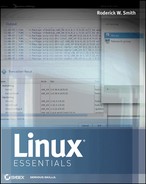APPENDIX B
LPI's Certification Program
The purpose of the Linux Essentials Program is to define the basic knowledge required to competently use a desktop or mobile device using a Linux operating system. The program guides and encourages those who are new to Linux, and to open source in general, to understand the place of these tools in the context of the broader IT industry.
The program is made up of several main components:
 Linux Essentials Exam and Certification
Linux Essentials Exam and Certification Support for worldwide participation in the World Skills Information and Communications Technology Category, IT Network Systems Administration
Support for worldwide participation in the World Skills Information and Communications Technology Category, IT Network Systems Administration Regional links to employability and apprenticeship programs available to youth
Regional links to employability and apprenticeship programs available to youth Research and resources supporting youth entry into Linux and open source careers
Research and resources supporting youth entry into Linux and open source careers Linux Professional Institute (LPI) support for regional government and educational qualification authorities where appropriate
Linux Professional Institute (LPI) support for regional government and educational qualification authorities where appropriate LPI support for teacher collaboration and sharing of projects and exercises for the Linux Essentials knowledge base
LPI support for teacher collaboration and sharing of projects and exercises for the Linux Essentials knowledge base Resources for youth describing jobs and industries requiring Linux skills
Resources for youth describing jobs and industries requiring Linux skills
The Linux Essentials Certification
The successful Linux Essentials candidate should have an understanding of the Linux and open source industry and knowledge of the most popular open source applications. The candidate should understand the major components of the Linux operating system and have the technical proficiency to work on the Linux command line. The candidate has at least a basic understanding of security- and administration-related topics such as managing users and groups, working on the command line, and using permissions. An LPI Linux Essentials Technician (LPI LET) is most likely the end user of a mostly managed system.
The LPI LET, at a minimum, typically:
 Has a basic understanding of free and open source software, the various communities and licenses
Has a basic understanding of free and open source software, the various communities and licenses Understands the basic concepts of processes, programs, and components of an operating system
Understands the basic concepts of processes, programs, and components of an operating system Has a basic knowledge of computer hardware
Has a basic knowledge of computer hardware Has a basic appreciation of system security, users/groups, and file permissions for public and private directories
Has a basic appreciation of system security, users/groups, and file permissions for public and private directories Has a basic understanding of how to make the system accessible and is able to connect to other computers on a local area network (LAN)
Has a basic understanding of how to make the system accessible and is able to connect to other computers on a local area network (LAN) Demonstrates a knowledge of open source applications in the work-place as they relate to closed source equivalents
Demonstrates a knowledge of open source applications in the work-place as they relate to closed source equivalents Understands navigation systems on a Linux desktop and where to go for help
Understands navigation systems on a Linux desktop and where to go for help Has a rudimentary ability to work on the command line and with files
Has a rudimentary ability to work on the command line and with files Is able to make and restore simple backups and archives
Is able to make and restore simple backups and archives Can use a basic command-line editor
Can use a basic command-line editor Understands file compression
Understands file compression Is able to create and run simple scripts
Is able to create and run simple scripts
Certification Objectives Map
Table B.1 provides approximate objective mappings for the LPI Linux Essentials Program. It identifies the chapters and sections where the exam objectives are covered. Be aware, however, that some specific programs and technologies are mentioned in multiple objectives, so you may find more complete coverage of some topics in chapters other than those noted in Table B.1. Consult this book's index if you need help finding a specific subject.
TABLE B.1 LPI Linux Essentials objectives map
| Objectives | Chapter(s) |
| Topic 1: A Career in Open Source and Joining the Linux Community | |
| 1.1 Linux Evolution and Popular Operating Systems | Chapters 1, 2 |
| 1.2 Major Open Source Applications | Chapter 4 |
| 1.3 Understanding Open Source Software and Licensing | Chapter 3 |
| 1.4 ICT Skills and Working in Linux | Chapter 4 |
| Topic 2: Finding Your Way on a Linux System | |
| 2.1 Command-Line Basics | Chapters 6, 12 |
| 2.2 Using the Command Line to Get Help | Chapter 8 |
| 2.3 Using Directories and Listing Files | Chapter 6 |
| 2.4 Creating, Moving, and Deleting Files | Chapter 7 |
| Topic 3: The power of the Command Line | |
| 3.1 Archiving Files on the Command Line | Chapter 10 |
| 3.2 Searching and Extracting Data from Files | Chapter 10 |
| 3.3 Turning Commands into a Script | Chapters 11, 12 |
| Topic 4: The Linux Operating System | |
| 4.1 Choosing an Operating System | Chapter 1 |
| 4.2 Understanding Computer Hardware | Chapter 5 |
| 4.3 Where Data Is Stored | Chapter 9 |
| 4.4 Your Computer on the Network | Chapter 17 |
| Topic 5: Security and File Permissions | |
| 5.1 Basic Security and Identifying User Types | Chapter 13 |
| 5.2 Creating Users and Groups | Chapter 14 |
| 5.3 Managing File Permissions and Ownership | Chapter 15 |
| 5.4 Special Directories and Files | Chapter 16 |
